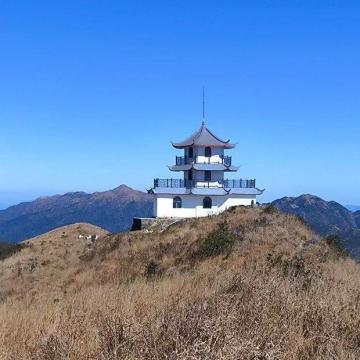
Protecting Plant "Living Fossils": Conservation and Monitoring of Cathaya argyrophylla(银杉) in the Bamianshan Nature Reserve

As a botanical "living fossil," Cathaya argyrophylla in the Bamianshan Nature Reserve faces severe survival challenges. The extreme drought of 2022 pushed its communities to the brink of withering, exacerbated by habitat fragility, necessitating systematic conservation measures. In 2024, the Bamianshan Nature Reserve launched a specialized protection project for Cathaya argyrophylla. Through labeling individuals, establishing permanent sample plots and monitoring sites, the project systematically investigates population structure and habitat characteristics. These efforts accurately delineate the age composition of Cathaya argyrophylla, assess its natural regeneration capacity, and provide a scientific basis for targeted conservation and climate change adaptation.
Context
Challenges addressed
The survival of Cathaya argyrophylla in the Bamianshan Nature Reserve faces severe challenges, primarily manifested in two key aspects:1.The direct threat of extreme climate events. The extreme drought in 2022 demonstrated that Cathaya argyrophylla communities are directly bearing the impact of climate change, facing the risk of mortality due to drought stress. 2.An intrinsic crisis in population regeneration. Influenced by the inherent fragility of its habitat, the age structure of the Cathaya argyrophylla population risks becoming unbalanced. A low proportion of saplings leads to a weakened natural regeneration capacity, posing a fundamental threat to the population's long-term persistence and sustainable development.
Location
Process
Summary of the process
This project follows the technical pathway of "Tagging and Positioning → Plot Monitoring → Community Survey," establishing a multi-tiered monitoring and conservation system that progresses from the individual tree to the entire community, and from specific points to the whole ecosystem. It has enabled a comprehensive understanding of the Cathaya argyrophylla population's distribution and growth status. This initiative signifies a shift from single-species conservation to the holistic protection of the ecosystem, enhancing the reserve's capacity to address systemic threats like climate change. Consequently, it not only safeguards individual Cathaya argyrophylla trees but also preserves the integrity and stability of their surrounding ecosystem.
Building Blocks
标记 Cathaya argyrophylla
In order to accurately determine the size of the Cathaya argyrophylla population in the Nature Reserve and to keep track of its basic status, we attached durable, unique identification tags to each tree. Each nameplate has a unique serial number, species name (Cathaya argyrophylla ), protection level, and a customized QR code. Along with the tagging, a comprehensive "health check" is performed on each tree, recording all data to create a "personal profile". Key parameters recorded include: serial number, location coordinates (latitude and longitude), elevation, tree height, DBH (diameter at breast height), crown spread, vigor of growth, slope direction, slope position, soil exposure status, associated plant species, and the presence of any pests, diseases, mechanical damages, dead branches, or other visible conditions.
Enabling factors
Prior to the tagging operation, the Nature Reserve already had a preliminary knowledge of the distribution of Cathaya argyrophylla through daily patrols and general surveys. With this prior knowledge, we were able to target our tagging efforts, which helped to develop optimal routes and efficient staff allocation.
Lesson learned
Durable materials that are resistant to sun, rain, and corrosion, such as metal, polyvinyl chloride, or composite materials, should be selected. Tightening methods should use flexible straps that will not damage the tree, leaving enough room for growth and avoiding a "noose" or "embedded girdle" effect.
Cathaya argyrophylla 社区监
A 1-hectare (hm²) permanent large sample plot of Cathaya argyrophylla containing 25 fixed quadrats was established. Within each tree quadrat, shrub subplots (5 m × 5 m) were located at the four corners and at the center. In addition, a herbaceous sub-site (1 m × 1 m) was located within each shrub sub-site to facilitate habitat monitoring.
Priority survey areas were designated in areas with relatively high concentrations of Cathaya argyrophylla 's natural distribution, and 20 m × 20 m monitoring plots were established in these areas. These plots were used to investigate community structure, natural regeneration, species diversity, habitat conditions, population structure and population dynamics. All monitoring data were systematically stored, managed and statistically analyzed.
Enabling factors
The reserve has established a stable partnership with scientific institutions. Previous comprehensive scientific surveys in the Reserve have provided a preliminary understanding of the distribution of Cathaya argyrophylla and facilitated the scientific placement of sample plots.
Lesson learned
Prior to the establishment of sample plots, a systematic baseline survey must be conducted. Depending on ecological principles, random, systematic or gradient distribution methods should be used to ensure that the sample plots are representative of the variety of habitats of Cathaya argyrophylla in the reserve.
Impacts
(1) Achieving Precision in Conservation Management: By tagging and mapping individual trees, the project establishes identity records for each Cathaya argyrophylla, shifting conservation from generalized stewardship to precise management. This enables the traceability and tracking of growth conditions for every tree.
(2) Enhancing Systematic Scientific Monitoring: The establishment of permanent sample plots standardizes and systematizes population dynamic monitoring, providing reliable data support for analyzing age structure and evaluating regeneration capacity.
(3) Expanding Dimensions of Ecological Protection: Community surveys extend the scope of conservation from a single species to the entire ecosystem level. By understanding the symbiotic relationships between Cathaya argyrophylla and associated species, the project strengthens comprehensive ecosystem conservation capabilities.
(4) Strengthening Risk Response Capacity: The systematic monitoring network facilitates timely warnings about climate change impacts on Cathaya argyrophylla communities, providing scientific basis for developing adaptive conservation strategies.
Beneficiaries
- Bamianshan Administration
- Scientific Research Institutions
- Guidong County Government
- Guidong County Forestry Bureau
- Guidong County Bureau of Natural Resources









